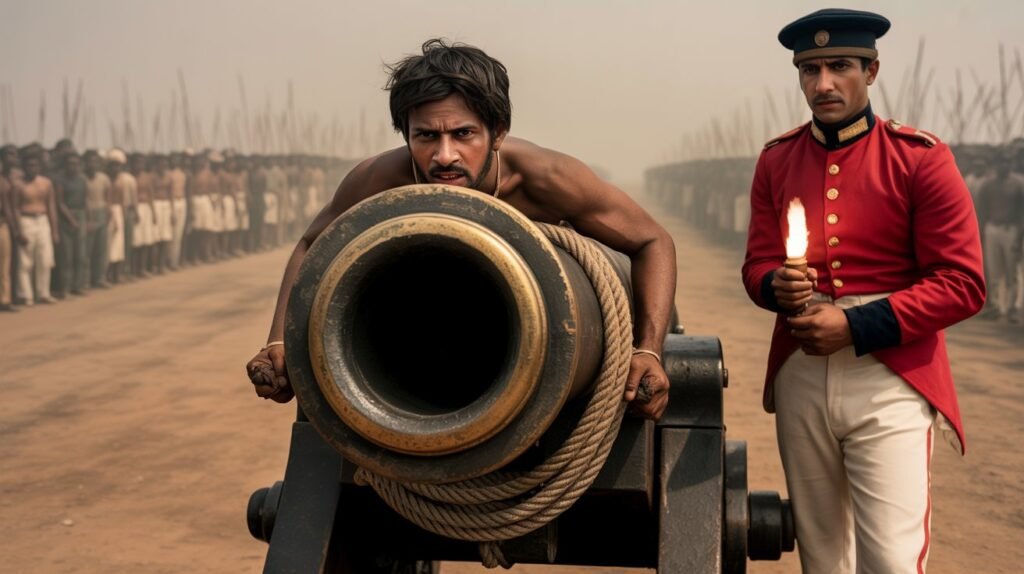
Introduction: The Empire and Its Shadow
The British Empire, once hailed as the largest and most powerful imperial force in history, ruled over vast territories across Asia, Africa, and the Americas. While its admirers often glorify the technological progress and administrative structures it introduced, a darker side of British rule is often overlooked: its brutal mechanisms of control. Among these, few punishments illustrate the depths of colonial violence as starkly as “blowing from a gun.”
This method of execution—tying a human being to the mouth of a cannon and blasting them into pieces—was not only physically obliterating, but symbolically crushing. It was used to demonstrate the overwhelming, ruthless power of the colonizer, and it left lasting scars on both collective memory and cultural identity.
Origins and Historical Background
“Blowing from a gun” did not originate with the British. This method of execution dates back at least to the 16th century in South Asia, where the Mughal Empire and other regional powers sometimes used cannons for executing traitors. The visual spectacle of the act and its horrific impact on the body were believed to intimidate would-be rebels.
When the British East India Company began expanding its control in India in the 18th and 19th centuries, they adapted local practices to suit their own needs—but with an added dose of imperial theatricality.
The 1857 Indian Rebellion and the Use of Cannons
Background of the Rebellion
The Indian Rebellion of 1857, sometimes called the Sepoy Mutiny by colonial historians, was a watershed moment in Indian history. It was sparked by a combination of political discontent, religious tension, and economic exploitation. A key trigger was the introduction of the Enfield rifle, whose cartridges were rumored to be greased with cow and pig fat—deeply offensive to both Hindu and Muslim soldiers (sepoys).
Public Executions and Symbolic Violence
After retaking control from the rebels, the British launched a brutal campaign of public executions. “Blowing from a gun” became one of the most feared methods, used not only to eliminate but to terrify. Eyewitness accounts describe scenes of prisoners tied to cannons, the blasts scattering their bodies before shocked crowds. British officers justified it as “prevention,” a warning to others.
Religious and Cultural Implications
This punishment wasn’t just about death—it was also an assault on the victim’s religious identity. For Hindus, bodily dismemberment meant the soul could not reincarnate. For Muslims, the lack of burial and mutilation violated religious rites. The British used this method knowing it inflicted lasting spiritual and cultural harm.
Visual and Artistic Depictions
The practice was captured famously in Vasily Vereshchagin’s 1884 painting, “Suppression of the Indian Revolt by the English.” The painting, while controversial in Britain, graphically illustrated the horror of this punishment and became a lasting symbol of colonial oppression.
Psychological Warfare and the Colonial Mindset
The purpose of such cruelty was clear: instill fear. The British believed order could only be maintained through terror. “Blowing from a gun” served as:
- A deterrent
- A method of punishment
- A display of imperial superiority
- A spiritual erasure
It was psychological warfare, designed to crush resistance in mind and spirit.
Eyewitness Reports and British Justifications
British officers often recorded these events without remorse. General James Neill and Lieutenant-Colonel William Hodson ordered such executions, calling them necessary to restore “civilized” order. Some British newspapers expressed concern, but most supported the measures.
Colonialism and Dehumanization
The use of this punishment reflects the racial mindset of the empire. Indian lives were seen as expendable. No European rebels would ever face such a fate. This was about asserting the superiority of white colonial rulers over “uncivilized” natives.
The Global Context: Was It Unique to India?
Though used primarily in India, similar forms of public terror were employed in other British colonies. However, India remained the main theater for this punishment due to the scale of resistance and the symbolic nature of the 1857 rebellion.
Modern Interpretations and Historical Reckoning
Today, historians and authors such as Shashi Tharoor and William Dalrymple have highlighted how such violence was part of the empire’s systemic brutality—not an anomaly. Postcolonial scholarship now emphasizes that empire was built not just on trade and governance, but on violence and humiliation.
Legacy and Cultural Memory in India
The memory of this punishment lingers in Indian collective consciousness. Oral histories speak of ancestors who died in this manner. Independence leaders used these stories to rally the people. Memorials and museums today pay tribute to the victims—not just as rebels, but as heroes.
Ethical Reflections: Can Empires Be Just?
This punishment forces us to ask: can a system that uses such methods ever be considered just? Can it ever be called civilizing? The answer is found in the shattered bodies of those executed and the fear they instilled in generations to come.
Conclusion: Remembering to Never Repeat
“Blowing from a gun” is more than an execution—it is a metaphor for how empires destroy not just bodies, but cultures and spirits. By remembering these atrocities, we pay homage to the resilience of those who suffered and resisted. The empire may be gone, but its shadows remain, reminding us to never forget the true cost of conquest.
Related Trusted Sources
-
Wikipedia – Blowing from a Gun
: Overview of the practice, its history, and usage across empires. -
Cambridge Journal – Execution by Cannon
: Scholarly article discussing the use of cannon executions by the British. -
Library of Congress – Historical Image
: A powerful print by Vasily Vereshchagin depicting the punishment. -
National Army Museum – Execution Depiction
: Illustration of mutineers being executed by cannon during the 1857 Rebellion. -
YouTube Documentary – Blowing from a Gun
: Short video providing historical context and analysis.
Sofa Super Store Fire: A Tragedy That Left an Indelible Mark on Fire Safety History
[…] Blowing from a Gun: Brutal Punishment in British India […]